Analysis of Aircraft Accidents and Stall Prevention Strategies Report
VerifiedAdded on 2021/02/20
|24
|9525
|31
Report
AI Summary
This report delves into the critical issue of aircraft stalls, a major cause of fatal accidents in aviation history. It begins with an introduction highlighting the significance of loss of control and stall events, referencing the International Civil Aviation Organization's observations. The literature review examines various perspectives on stall occurrences, including the roles of aerodynamic principles, pilot training, and stall warning systems. The analysis of aircraft accidents, primarily from the USA and the Australian Transport Safety Bureau, provides insights into the common causes and contributing factors. The report then explores safety trends in the air transport industry, with a focus on dynamic stall, prediction models, and the main stages of flight, including the stall envelope. The report concludes by summarizing the key findings and recommendations for improving flight safety and preventing future accidents related to stalls. The report emphasizes the importance of pilot training, awareness of aerodynamic principles, and the implementation of effective stall warning and recovery systems. The report also emphasizes the role of technology and design in preventing stalls.
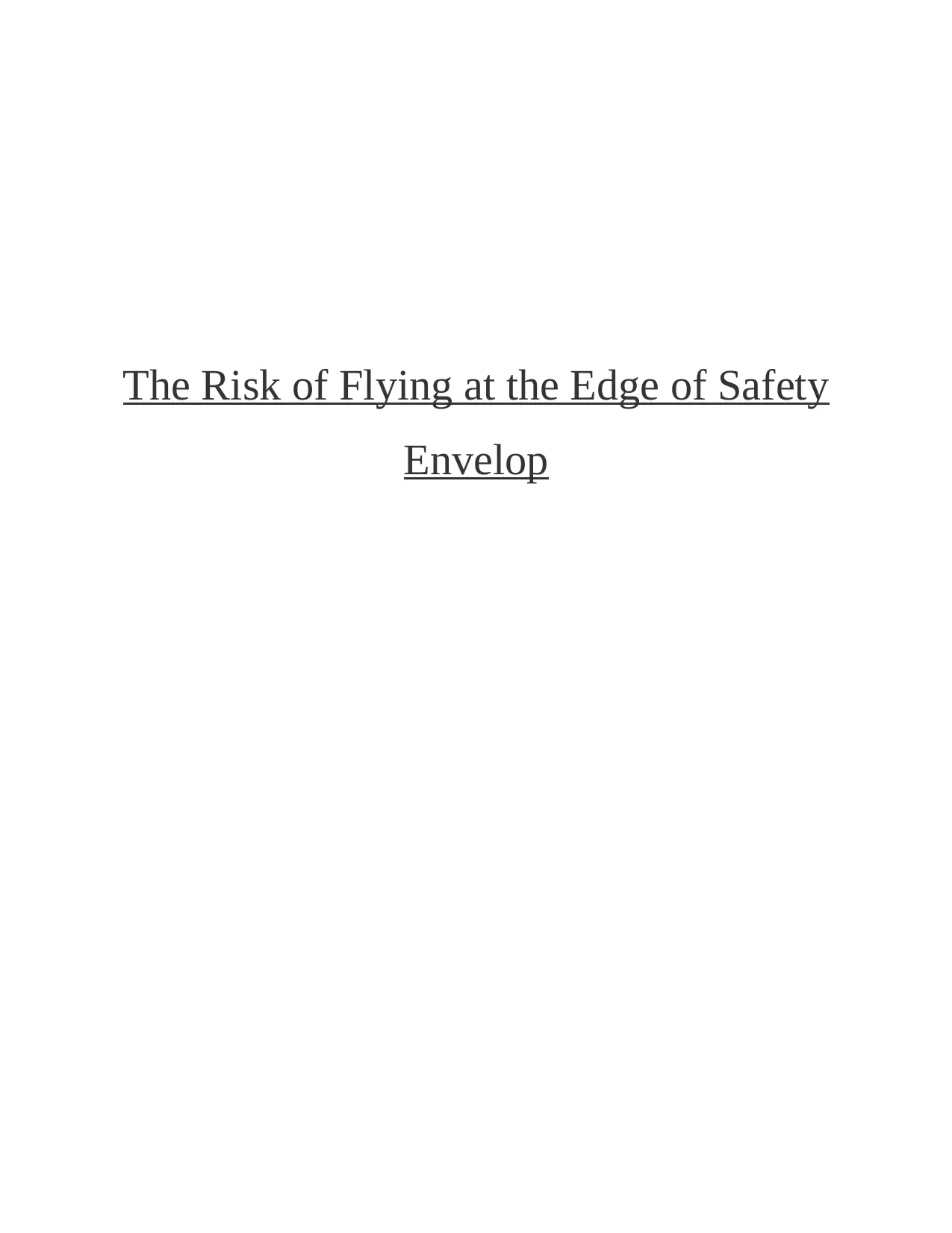
The Risk of Flying at the Edge of Safety
Envelop
Envelop
Paraphrase This Document
Need a fresh take? Get an instant paraphrase of this document with our AI Paraphraser
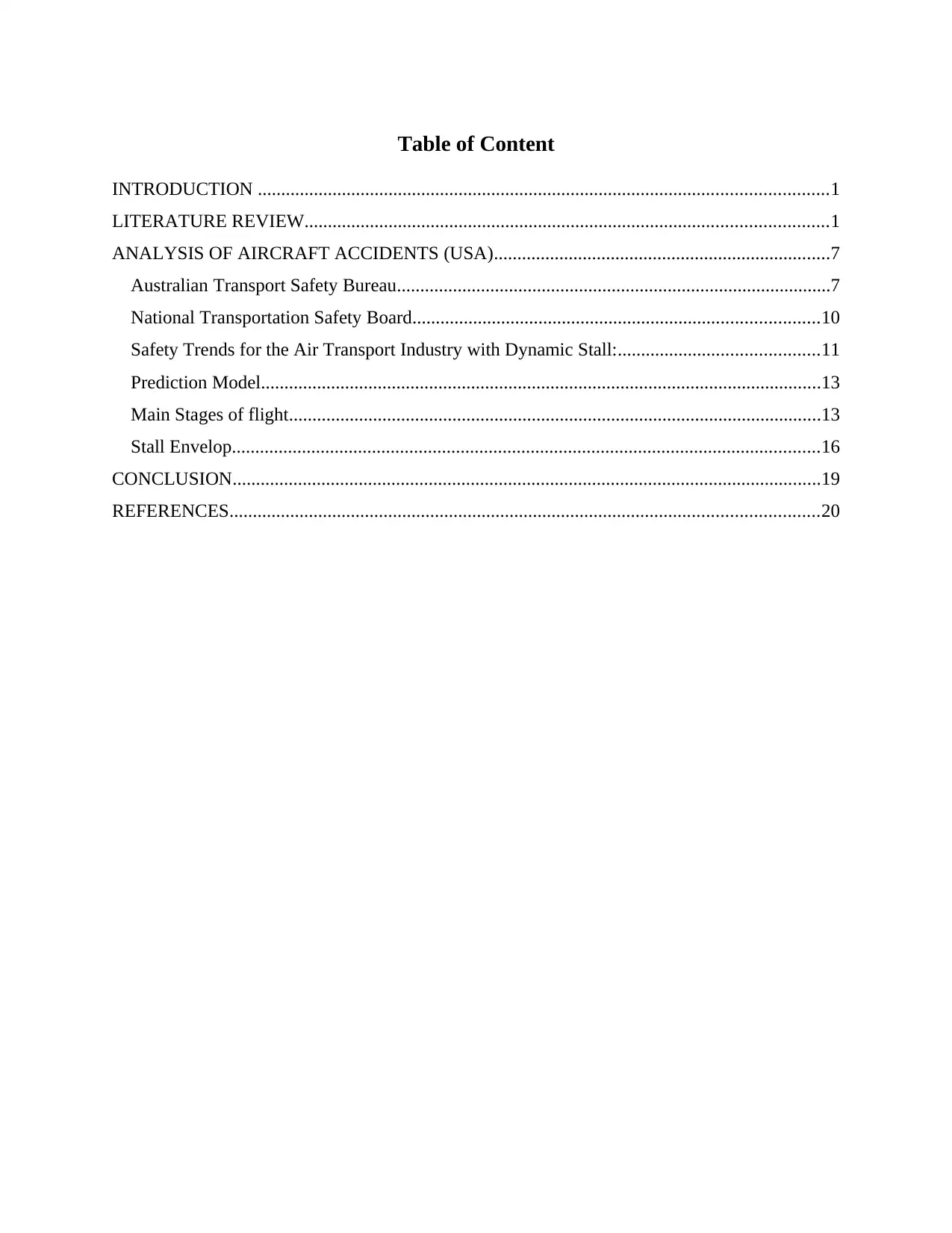
Table of Content
INTRODUCTION ..........................................................................................................................1
LITERATURE REVIEW................................................................................................................1
ANALYSIS OF AIRCRAFT ACCIDENTS (USA)........................................................................7
Australian Transport Safety Bureau.............................................................................................7
National Transportation Safety Board.......................................................................................10
Safety Trends for the Air Transport Industry with Dynamic Stall:...........................................11
Prediction Model........................................................................................................................13
Main Stages of flight..................................................................................................................13
Stall Envelop..............................................................................................................................16
CONCLUSION..............................................................................................................................19
REFERENCES..............................................................................................................................20
INTRODUCTION ..........................................................................................................................1
LITERATURE REVIEW................................................................................................................1
ANALYSIS OF AIRCRAFT ACCIDENTS (USA)........................................................................7
Australian Transport Safety Bureau.............................................................................................7
National Transportation Safety Board.......................................................................................10
Safety Trends for the Air Transport Industry with Dynamic Stall:...........................................11
Prediction Model........................................................................................................................13
Main Stages of flight..................................................................................................................13
Stall Envelop..............................................................................................................................16
CONCLUSION..............................................................................................................................19
REFERENCES..............................................................................................................................20
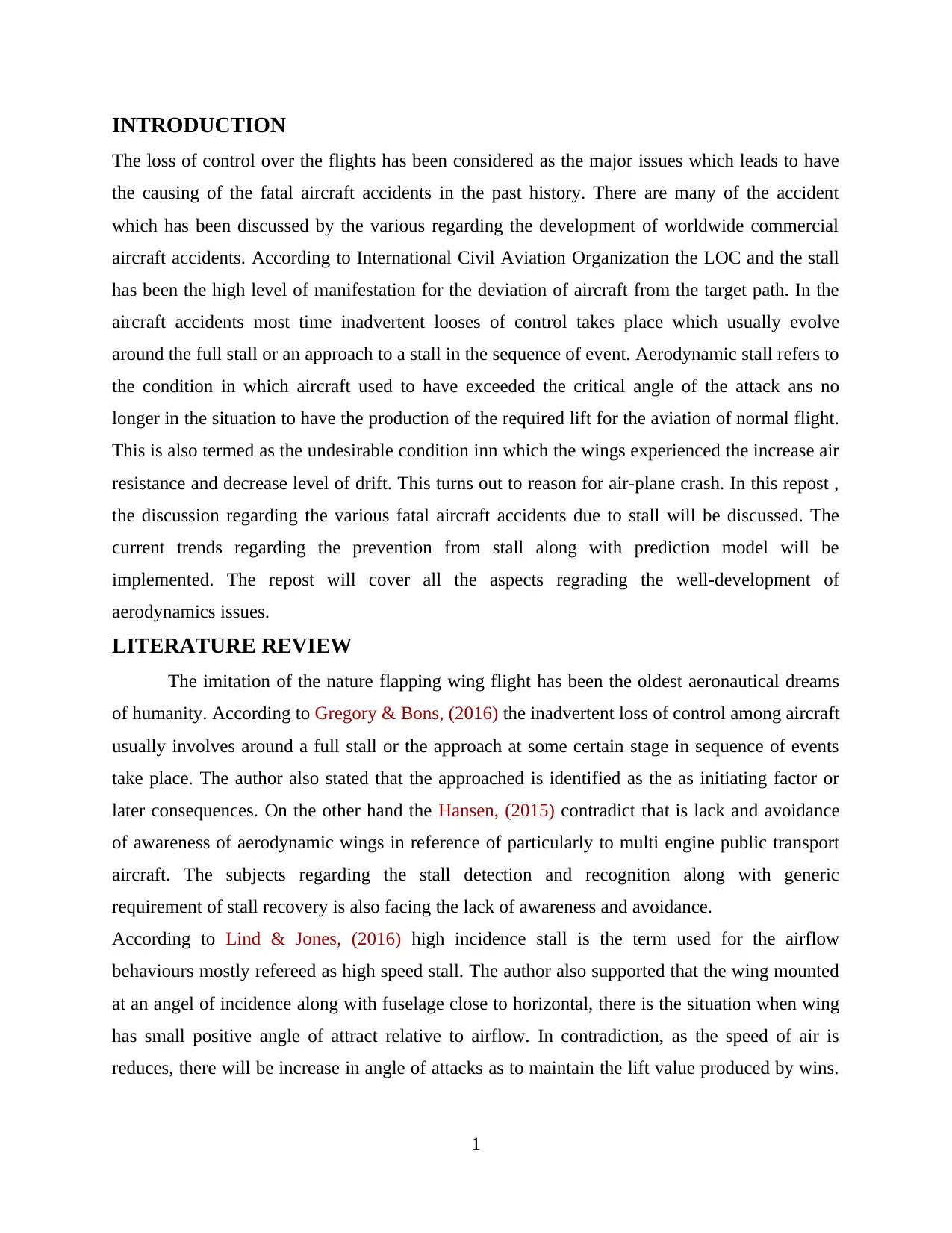
INTRODUCTION
The loss of control over the flights has been considered as the major issues which leads to have
the causing of the fatal aircraft accidents in the past history. There are many of the accident
which has been discussed by the various regarding the development of worldwide commercial
aircraft accidents. According to International Civil Aviation Organization the LOC and the stall
has been the high level of manifestation for the deviation of aircraft from the target path. In the
aircraft accidents most time inadvertent looses of control takes place which usually evolve
around the full stall or an approach to a stall in the sequence of event. Aerodynamic stall refers to
the condition in which aircraft used to have exceeded the critical angle of the attack ans no
longer in the situation to have the production of the required lift for the aviation of normal flight.
This is also termed as the undesirable condition inn which the wings experienced the increase air
resistance and decrease level of drift. This turns out to reason for air-plane crash. In this repost ,
the discussion regarding the various fatal aircraft accidents due to stall will be discussed. The
current trends regarding the prevention from stall along with prediction model will be
implemented. The repost will cover all the aspects regrading the well-development of
aerodynamics issues.
LITERATURE REVIEW
The imitation of the nature flapping wing flight has been the oldest aeronautical dreams
of humanity. According to Gregory & Bons, (2016) the inadvertent loss of control among aircraft
usually involves around a full stall or the approach at some certain stage in sequence of events
take place. The author also stated that the approached is identified as the as initiating factor or
later consequences. On the other hand the Hansen, (2015) contradict that is lack and avoidance
of awareness of aerodynamic wings in reference of particularly to multi engine public transport
aircraft. The subjects regarding the stall detection and recognition along with generic
requirement of stall recovery is also facing the lack of awareness and avoidance.
According to Lind & Jones, (2016) high incidence stall is the term used for the airflow
behaviours mostly refereed as high speed stall. The author also supported that the wing mounted
at an angel of incidence along with fuselage close to horizontal, there is the situation when wing
has small positive angle of attract relative to airflow. In contradiction, as the speed of air is
reduces, there will be increase in angle of attacks as to maintain the lift value produced by wins.
1
The loss of control over the flights has been considered as the major issues which leads to have
the causing of the fatal aircraft accidents in the past history. There are many of the accident
which has been discussed by the various regarding the development of worldwide commercial
aircraft accidents. According to International Civil Aviation Organization the LOC and the stall
has been the high level of manifestation for the deviation of aircraft from the target path. In the
aircraft accidents most time inadvertent looses of control takes place which usually evolve
around the full stall or an approach to a stall in the sequence of event. Aerodynamic stall refers to
the condition in which aircraft used to have exceeded the critical angle of the attack ans no
longer in the situation to have the production of the required lift for the aviation of normal flight.
This is also termed as the undesirable condition inn which the wings experienced the increase air
resistance and decrease level of drift. This turns out to reason for air-plane crash. In this repost ,
the discussion regarding the various fatal aircraft accidents due to stall will be discussed. The
current trends regarding the prevention from stall along with prediction model will be
implemented. The repost will cover all the aspects regrading the well-development of
aerodynamics issues.
LITERATURE REVIEW
The imitation of the nature flapping wing flight has been the oldest aeronautical dreams
of humanity. According to Gregory & Bons, (2016) the inadvertent loss of control among aircraft
usually involves around a full stall or the approach at some certain stage in sequence of events
take place. The author also stated that the approached is identified as the as initiating factor or
later consequences. On the other hand the Hansen, (2015) contradict that is lack and avoidance
of awareness of aerodynamic wings in reference of particularly to multi engine public transport
aircraft. The subjects regarding the stall detection and recognition along with generic
requirement of stall recovery is also facing the lack of awareness and avoidance.
According to Lind & Jones, (2016) high incidence stall is the term used for the airflow
behaviours mostly refereed as high speed stall. The author also supported that the wing mounted
at an angel of incidence along with fuselage close to horizontal, there is the situation when wing
has small positive angle of attract relative to airflow. In contradiction, as the speed of air is
reduces, there will be increase in angle of attacks as to maintain the lift value produced by wins.
1
⊘ This is a preview!⊘
Do you want full access?
Subscribe today to unlock all pages.

Trusted by 1+ million students worldwide
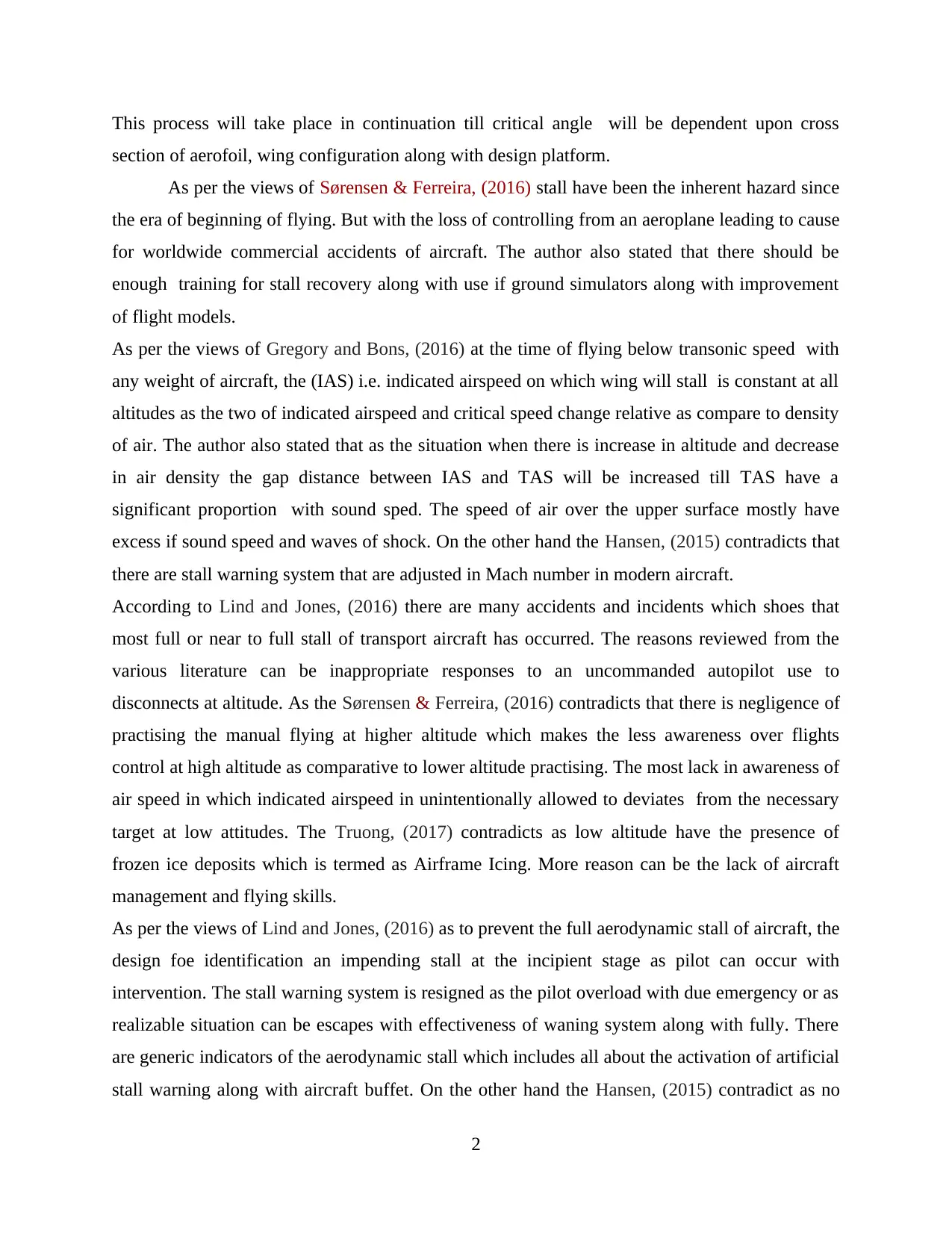
This process will take place in continuation till critical angle will be dependent upon cross
section of aerofoil, wing configuration along with design platform.
As per the views of Sørensen & Ferreira, (2016) stall have been the inherent hazard since
the era of beginning of flying. But with the loss of controlling from an aeroplane leading to cause
for worldwide commercial accidents of aircraft. The author also stated that there should be
enough training for stall recovery along with use if ground simulators along with improvement
of flight models.
As per the views of Gregory and Bons, (2016) at the time of flying below transonic speed with
any weight of aircraft, the (IAS) i.e. indicated airspeed on which wing will stall is constant at all
altitudes as the two of indicated airspeed and critical speed change relative as compare to density
of air. The author also stated that as the situation when there is increase in altitude and decrease
in air density the gap distance between IAS and TAS will be increased till TAS have a
significant proportion with sound sped. The speed of air over the upper surface mostly have
excess if sound speed and waves of shock. On the other hand the Hansen, (2015) contradicts that
there are stall warning system that are adjusted in Mach number in modern aircraft.
According to Lind and Jones, (2016) there are many accidents and incidents which shoes that
most full or near to full stall of transport aircraft has occurred. The reasons reviewed from the
various literature can be inappropriate responses to an uncommanded autopilot use to
disconnects at altitude. As the Sørensen & Ferreira, (2016) contradicts that there is negligence of
practising the manual flying at higher altitude which makes the less awareness over flights
control at high altitude as comparative to lower altitude practising. The most lack in awareness of
air speed in which indicated airspeed in unintentionally allowed to deviates from the necessary
target at low attitudes. The Truong, (2017) contradicts as low altitude have the presence of
frozen ice deposits which is termed as Airframe Icing. More reason can be the lack of aircraft
management and flying skills.
As per the views of Lind and Jones, (2016) as to prevent the full aerodynamic stall of aircraft, the
design foe identification an impending stall at the incipient stage as pilot can occur with
intervention. The stall warning system is resigned as the pilot overload with due emergency or as
realizable situation can be escapes with effectiveness of waning system along with fully. There
are generic indicators of the aerodynamic stall which includes all about the activation of artificial
stall warning along with aircraft buffet. On the other hand the Hansen, (2015) contradict as no
2
section of aerofoil, wing configuration along with design platform.
As per the views of Sørensen & Ferreira, (2016) stall have been the inherent hazard since
the era of beginning of flying. But with the loss of controlling from an aeroplane leading to cause
for worldwide commercial accidents of aircraft. The author also stated that there should be
enough training for stall recovery along with use if ground simulators along with improvement
of flight models.
As per the views of Gregory and Bons, (2016) at the time of flying below transonic speed with
any weight of aircraft, the (IAS) i.e. indicated airspeed on which wing will stall is constant at all
altitudes as the two of indicated airspeed and critical speed change relative as compare to density
of air. The author also stated that as the situation when there is increase in altitude and decrease
in air density the gap distance between IAS and TAS will be increased till TAS have a
significant proportion with sound sped. The speed of air over the upper surface mostly have
excess if sound speed and waves of shock. On the other hand the Hansen, (2015) contradicts that
there are stall warning system that are adjusted in Mach number in modern aircraft.
According to Lind and Jones, (2016) there are many accidents and incidents which shoes that
most full or near to full stall of transport aircraft has occurred. The reasons reviewed from the
various literature can be inappropriate responses to an uncommanded autopilot use to
disconnects at altitude. As the Sørensen & Ferreira, (2016) contradicts that there is negligence of
practising the manual flying at higher altitude which makes the less awareness over flights
control at high altitude as comparative to lower altitude practising. The most lack in awareness of
air speed in which indicated airspeed in unintentionally allowed to deviates from the necessary
target at low attitudes. The Truong, (2017) contradicts as low altitude have the presence of
frozen ice deposits which is termed as Airframe Icing. More reason can be the lack of aircraft
management and flying skills.
As per the views of Lind and Jones, (2016) as to prevent the full aerodynamic stall of aircraft, the
design foe identification an impending stall at the incipient stage as pilot can occur with
intervention. The stall warning system is resigned as the pilot overload with due emergency or as
realizable situation can be escapes with effectiveness of waning system along with fully. There
are generic indicators of the aerodynamic stall which includes all about the activation of artificial
stall warning along with aircraft buffet. On the other hand the Hansen, (2015) contradict as no
2
Paraphrase This Document
Need a fresh take? Get an instant paraphrase of this document with our AI Paraphraser
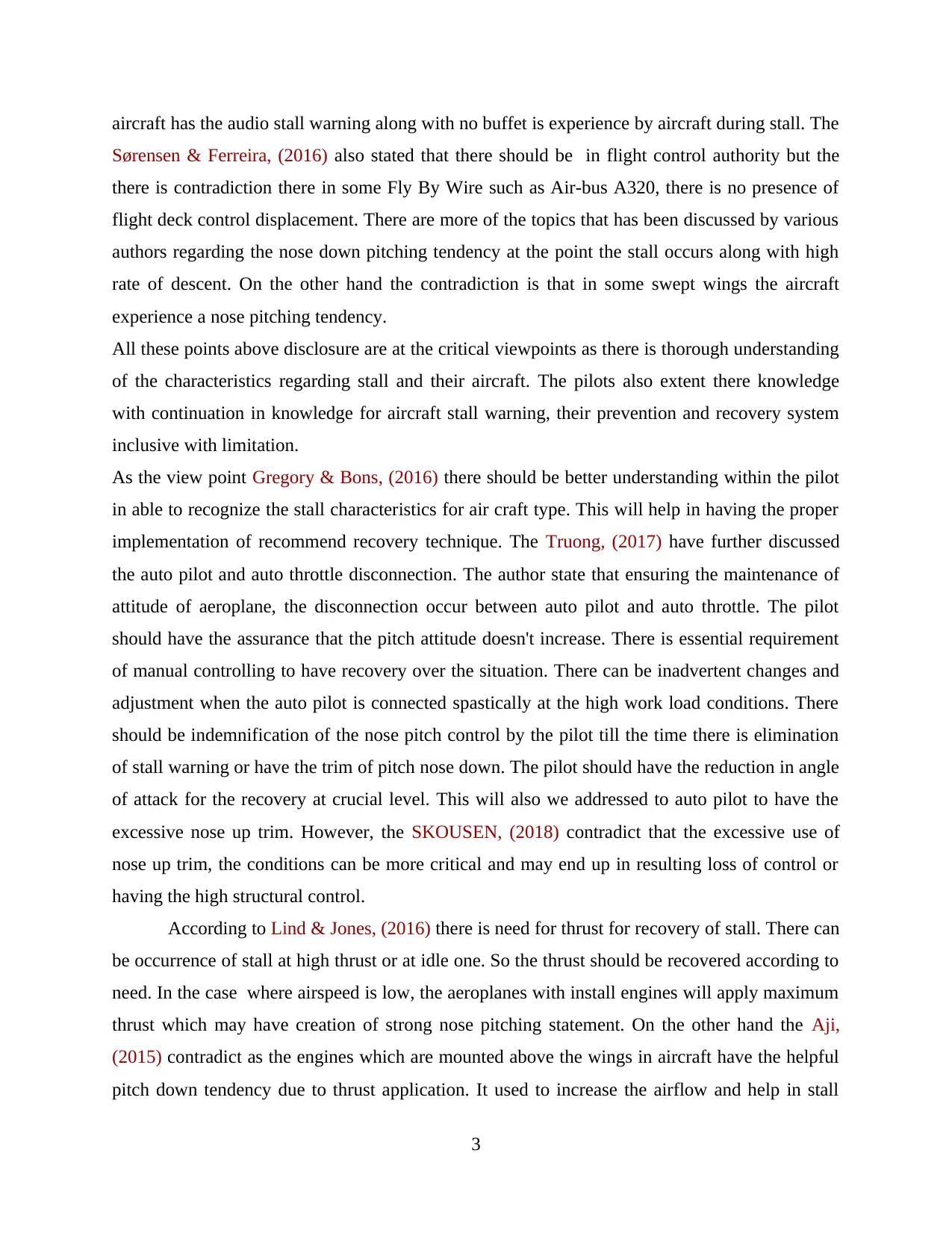
aircraft has the audio stall warning along with no buffet is experience by aircraft during stall. The
Sørensen & Ferreira, (2016) also stated that there should be in flight control authority but the
there is contradiction there in some Fly By Wire such as Air-bus A320, there is no presence of
flight deck control displacement. There are more of the topics that has been discussed by various
authors regarding the nose down pitching tendency at the point the stall occurs along with high
rate of descent. On the other hand the contradiction is that in some swept wings the aircraft
experience a nose pitching tendency.
All these points above disclosure are at the critical viewpoints as there is thorough understanding
of the characteristics regarding stall and their aircraft. The pilots also extent there knowledge
with continuation in knowledge for aircraft stall warning, their prevention and recovery system
inclusive with limitation.
As the view point Gregory & Bons, (2016) there should be better understanding within the pilot
in able to recognize the stall characteristics for air craft type. This will help in having the proper
implementation of recommend recovery technique. The Truong, (2017) have further discussed
the auto pilot and auto throttle disconnection. The author state that ensuring the maintenance of
attitude of aeroplane, the disconnection occur between auto pilot and auto throttle. The pilot
should have the assurance that the pitch attitude doesn't increase. There is essential requirement
of manual controlling to have recovery over the situation. There can be inadvertent changes and
adjustment when the auto pilot is connected spastically at the high work load conditions. There
should be indemnification of the nose pitch control by the pilot till the time there is elimination
of stall warning or have the trim of pitch nose down. The pilot should have the reduction in angle
of attack for the recovery at crucial level. This will also we addressed to auto pilot to have the
excessive nose up trim. However, the SKOUSEN, (2018) contradict that the excessive use of
nose up trim, the conditions can be more critical and may end up in resulting loss of control or
having the high structural control.
According to Lind & Jones, (2016) there is need for thrust for recovery of stall. There can
be occurrence of stall at high thrust or at idle one. So the thrust should be recovered according to
need. In the case where airspeed is low, the aeroplanes with install engines will apply maximum
thrust which may have creation of strong nose pitching statement. On the other hand the Aji,
(2015) contradict as the engines which are mounted above the wings in aircraft have the helpful
pitch down tendency due to thrust application. It used to increase the airflow and help in stall
3
Sørensen & Ferreira, (2016) also stated that there should be in flight control authority but the
there is contradiction there in some Fly By Wire such as Air-bus A320, there is no presence of
flight deck control displacement. There are more of the topics that has been discussed by various
authors regarding the nose down pitching tendency at the point the stall occurs along with high
rate of descent. On the other hand the contradiction is that in some swept wings the aircraft
experience a nose pitching tendency.
All these points above disclosure are at the critical viewpoints as there is thorough understanding
of the characteristics regarding stall and their aircraft. The pilots also extent there knowledge
with continuation in knowledge for aircraft stall warning, their prevention and recovery system
inclusive with limitation.
As the view point Gregory & Bons, (2016) there should be better understanding within the pilot
in able to recognize the stall characteristics for air craft type. This will help in having the proper
implementation of recommend recovery technique. The Truong, (2017) have further discussed
the auto pilot and auto throttle disconnection. The author state that ensuring the maintenance of
attitude of aeroplane, the disconnection occur between auto pilot and auto throttle. The pilot
should have the assurance that the pitch attitude doesn't increase. There is essential requirement
of manual controlling to have recovery over the situation. There can be inadvertent changes and
adjustment when the auto pilot is connected spastically at the high work load conditions. There
should be indemnification of the nose pitch control by the pilot till the time there is elimination
of stall warning or have the trim of pitch nose down. The pilot should have the reduction in angle
of attack for the recovery at crucial level. This will also we addressed to auto pilot to have the
excessive nose up trim. However, the SKOUSEN, (2018) contradict that the excessive use of
nose up trim, the conditions can be more critical and may end up in resulting loss of control or
having the high structural control.
According to Lind & Jones, (2016) there is need for thrust for recovery of stall. There can
be occurrence of stall at high thrust or at idle one. So the thrust should be recovered according to
need. In the case where airspeed is low, the aeroplanes with install engines will apply maximum
thrust which may have creation of strong nose pitching statement. On the other hand the Aji,
(2015) contradict as the engines which are mounted above the wings in aircraft have the helpful
pitch down tendency due to thrust application. It used to increase the airflow and help in stall
3
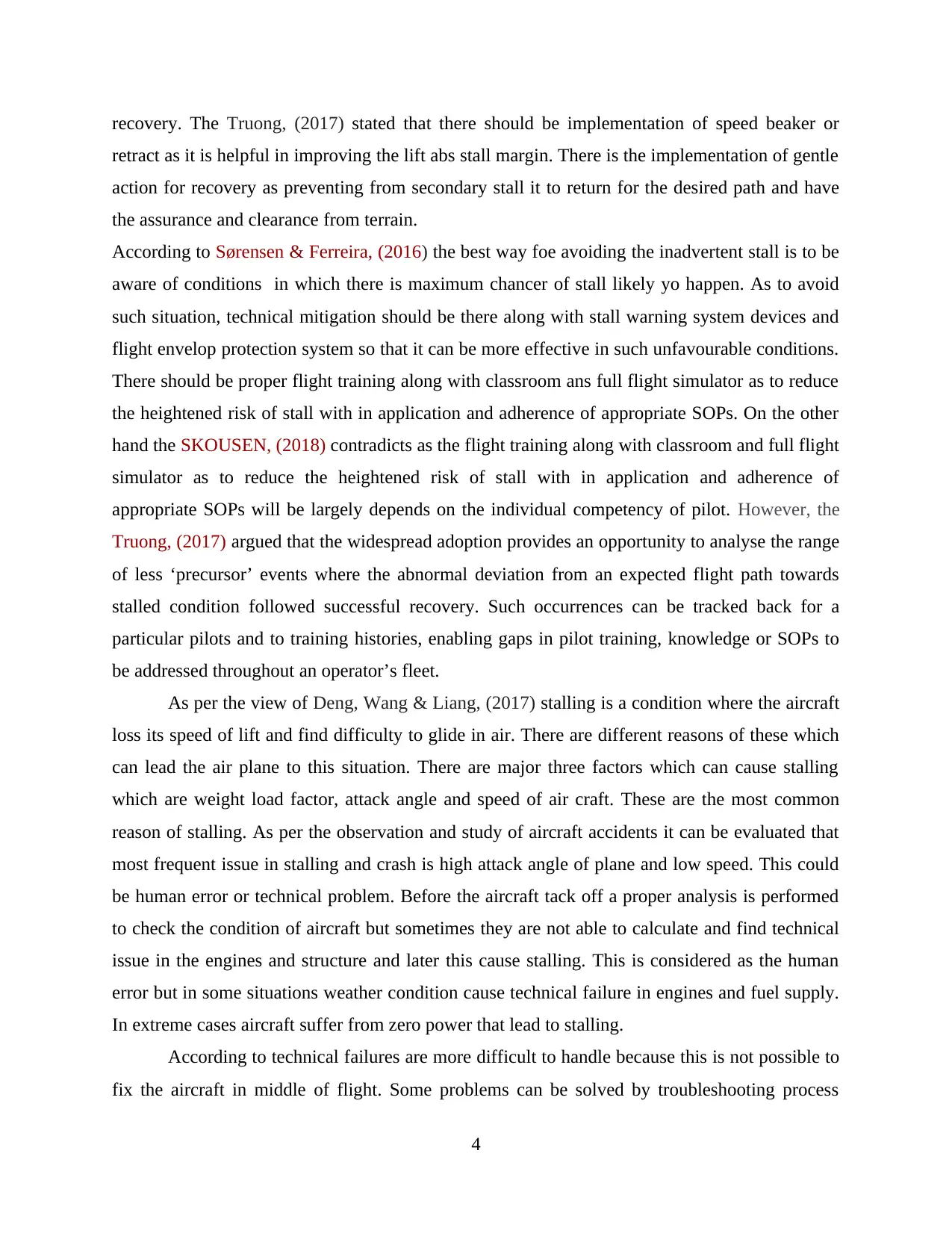
recovery. The Truong, (2017) stated that there should be implementation of speed beaker or
retract as it is helpful in improving the lift abs stall margin. There is the implementation of gentle
action for recovery as preventing from secondary stall it to return for the desired path and have
the assurance and clearance from terrain.
According to Sørensen & Ferreira, (2016) the best way foe avoiding the inadvertent stall is to be
aware of conditions in which there is maximum chancer of stall likely yo happen. As to avoid
such situation, technical mitigation should be there along with stall warning system devices and
flight envelop protection system so that it can be more effective in such unfavourable conditions.
There should be proper flight training along with classroom ans full flight simulator as to reduce
the heightened risk of stall with in application and adherence of appropriate SOPs. On the other
hand the SKOUSEN, (2018) contradicts as the flight training along with classroom and full flight
simulator as to reduce the heightened risk of stall with in application and adherence of
appropriate SOPs will be largely depends on the individual competency of pilot. However, the
Truong, (2017) argued that the widespread adoption provides an opportunity to analyse the range
of less ‘precursor’ events where the abnormal deviation from an expected flight path towards
stalled condition followed successful recovery. Such occurrences can be tracked back for a
particular pilots and to training histories, enabling gaps in pilot training, knowledge or SOPs to
be addressed throughout an operator’s fleet.
As per the view of Deng, Wang & Liang, (2017) stalling is a condition where the aircraft
loss its speed of lift and find difficulty to glide in air. There are different reasons of these which
can lead the air plane to this situation. There are major three factors which can cause stalling
which are weight load factor, attack angle and speed of air craft. These are the most common
reason of stalling. As per the observation and study of aircraft accidents it can be evaluated that
most frequent issue in stalling and crash is high attack angle of plane and low speed. This could
be human error or technical problem. Before the aircraft tack off a proper analysis is performed
to check the condition of aircraft but sometimes they are not able to calculate and find technical
issue in the engines and structure and later this cause stalling. This is considered as the human
error but in some situations weather condition cause technical failure in engines and fuel supply.
In extreme cases aircraft suffer from zero power that lead to stalling.
According to technical failures are more difficult to handle because this is not possible to
fix the aircraft in middle of flight. Some problems can be solved by troubleshooting process
4
retract as it is helpful in improving the lift abs stall margin. There is the implementation of gentle
action for recovery as preventing from secondary stall it to return for the desired path and have
the assurance and clearance from terrain.
According to Sørensen & Ferreira, (2016) the best way foe avoiding the inadvertent stall is to be
aware of conditions in which there is maximum chancer of stall likely yo happen. As to avoid
such situation, technical mitigation should be there along with stall warning system devices and
flight envelop protection system so that it can be more effective in such unfavourable conditions.
There should be proper flight training along with classroom ans full flight simulator as to reduce
the heightened risk of stall with in application and adherence of appropriate SOPs. On the other
hand the SKOUSEN, (2018) contradicts as the flight training along with classroom and full flight
simulator as to reduce the heightened risk of stall with in application and adherence of
appropriate SOPs will be largely depends on the individual competency of pilot. However, the
Truong, (2017) argued that the widespread adoption provides an opportunity to analyse the range
of less ‘precursor’ events where the abnormal deviation from an expected flight path towards
stalled condition followed successful recovery. Such occurrences can be tracked back for a
particular pilots and to training histories, enabling gaps in pilot training, knowledge or SOPs to
be addressed throughout an operator’s fleet.
As per the view of Deng, Wang & Liang, (2017) stalling is a condition where the aircraft
loss its speed of lift and find difficulty to glide in air. There are different reasons of these which
can lead the air plane to this situation. There are major three factors which can cause stalling
which are weight load factor, attack angle and speed of air craft. These are the most common
reason of stalling. As per the observation and study of aircraft accidents it can be evaluated that
most frequent issue in stalling and crash is high attack angle of plane and low speed. This could
be human error or technical problem. Before the aircraft tack off a proper analysis is performed
to check the condition of aircraft but sometimes they are not able to calculate and find technical
issue in the engines and structure and later this cause stalling. This is considered as the human
error but in some situations weather condition cause technical failure in engines and fuel supply.
In extreme cases aircraft suffer from zero power that lead to stalling.
According to technical failures are more difficult to handle because this is not possible to
fix the aircraft in middle of flight. Some problems can be solved by troubleshooting process
4
⊘ This is a preview!⊘
Do you want full access?
Subscribe today to unlock all pages.

Trusted by 1+ million students worldwide
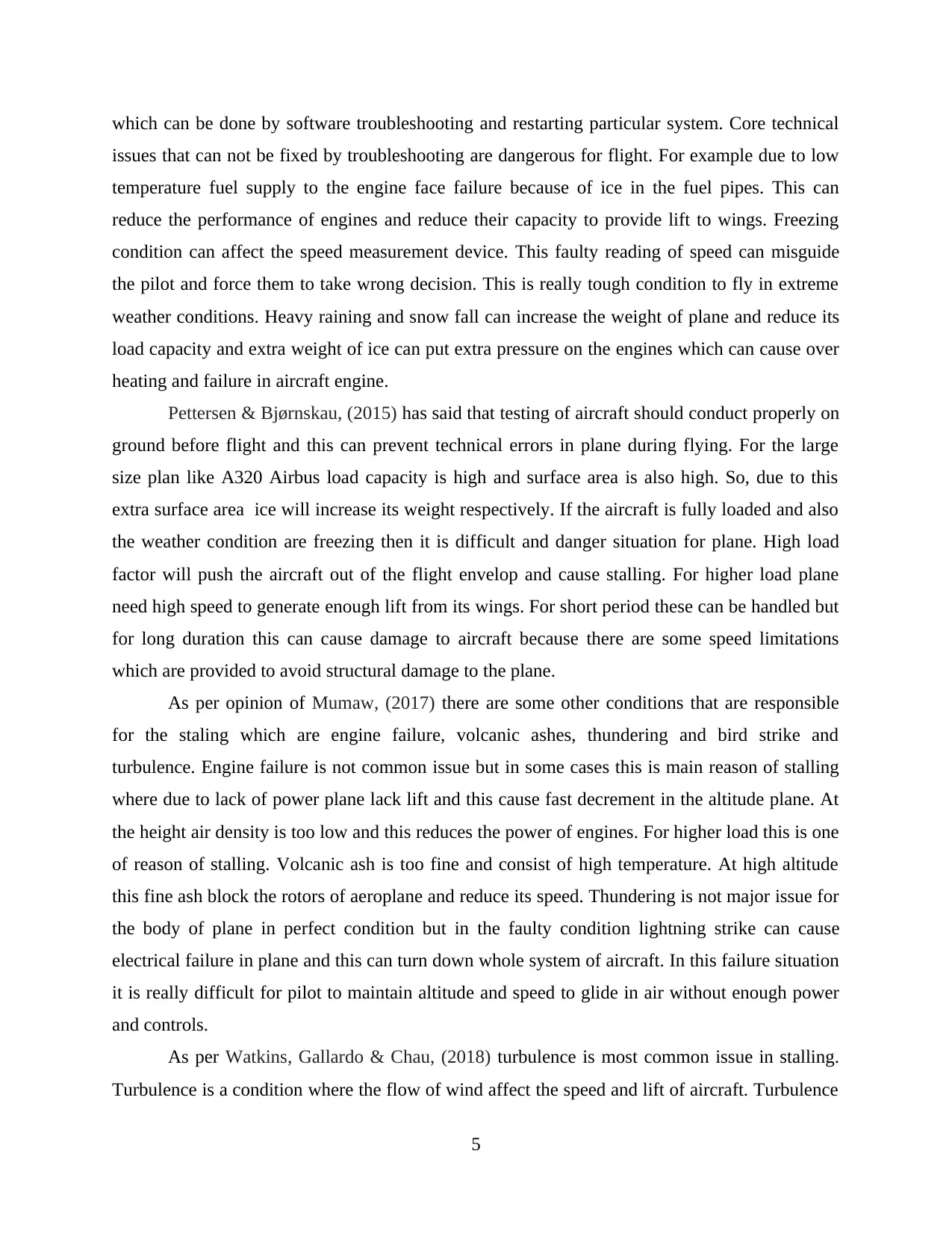
which can be done by software troubleshooting and restarting particular system. Core technical
issues that can not be fixed by troubleshooting are dangerous for flight. For example due to low
temperature fuel supply to the engine face failure because of ice in the fuel pipes. This can
reduce the performance of engines and reduce their capacity to provide lift to wings. Freezing
condition can affect the speed measurement device. This faulty reading of speed can misguide
the pilot and force them to take wrong decision. This is really tough condition to fly in extreme
weather conditions. Heavy raining and snow fall can increase the weight of plane and reduce its
load capacity and extra weight of ice can put extra pressure on the engines which can cause over
heating and failure in aircraft engine.
Pettersen & Bjørnskau, (2015) has said that testing of aircraft should conduct properly on
ground before flight and this can prevent technical errors in plane during flying. For the large
size plan like A320 Airbus load capacity is high and surface area is also high. So, due to this
extra surface area ice will increase its weight respectively. If the aircraft is fully loaded and also
the weather condition are freezing then it is difficult and danger situation for plane. High load
factor will push the aircraft out of the flight envelop and cause stalling. For higher load plane
need high speed to generate enough lift from its wings. For short period these can be handled but
for long duration this can cause damage to aircraft because there are some speed limitations
which are provided to avoid structural damage to the plane.
As per opinion of Mumaw, (2017) there are some other conditions that are responsible
for the staling which are engine failure, volcanic ashes, thundering and bird strike and
turbulence. Engine failure is not common issue but in some cases this is main reason of stalling
where due to lack of power plane lack lift and this cause fast decrement in the altitude plane. At
the height air density is too low and this reduces the power of engines. For higher load this is one
of reason of stalling. Volcanic ash is too fine and consist of high temperature. At high altitude
this fine ash block the rotors of aeroplane and reduce its speed. Thundering is not major issue for
the body of plane in perfect condition but in the faulty condition lightning strike can cause
electrical failure in plane and this can turn down whole system of aircraft. In this failure situation
it is really difficult for pilot to maintain altitude and speed to glide in air without enough power
and controls.
As per Watkins, Gallardo & Chau, (2018) turbulence is most common issue in stalling.
Turbulence is a condition where the flow of wind affect the speed and lift of aircraft. Turbulence
5
issues that can not be fixed by troubleshooting are dangerous for flight. For example due to low
temperature fuel supply to the engine face failure because of ice in the fuel pipes. This can
reduce the performance of engines and reduce their capacity to provide lift to wings. Freezing
condition can affect the speed measurement device. This faulty reading of speed can misguide
the pilot and force them to take wrong decision. This is really tough condition to fly in extreme
weather conditions. Heavy raining and snow fall can increase the weight of plane and reduce its
load capacity and extra weight of ice can put extra pressure on the engines which can cause over
heating and failure in aircraft engine.
Pettersen & Bjørnskau, (2015) has said that testing of aircraft should conduct properly on
ground before flight and this can prevent technical errors in plane during flying. For the large
size plan like A320 Airbus load capacity is high and surface area is also high. So, due to this
extra surface area ice will increase its weight respectively. If the aircraft is fully loaded and also
the weather condition are freezing then it is difficult and danger situation for plane. High load
factor will push the aircraft out of the flight envelop and cause stalling. For higher load plane
need high speed to generate enough lift from its wings. For short period these can be handled but
for long duration this can cause damage to aircraft because there are some speed limitations
which are provided to avoid structural damage to the plane.
As per opinion of Mumaw, (2017) there are some other conditions that are responsible
for the staling which are engine failure, volcanic ashes, thundering and bird strike and
turbulence. Engine failure is not common issue but in some cases this is main reason of stalling
where due to lack of power plane lack lift and this cause fast decrement in the altitude plane. At
the height air density is too low and this reduces the power of engines. For higher load this is one
of reason of stalling. Volcanic ash is too fine and consist of high temperature. At high altitude
this fine ash block the rotors of aeroplane and reduce its speed. Thundering is not major issue for
the body of plane in perfect condition but in the faulty condition lightning strike can cause
electrical failure in plane and this can turn down whole system of aircraft. In this failure situation
it is really difficult for pilot to maintain altitude and speed to glide in air without enough power
and controls.
As per Watkins, Gallardo & Chau, (2018) turbulence is most common issue in stalling.
Turbulence is a condition where the flow of wind affect the speed and lift of aircraft. Turbulence
5
Paraphrase This Document
Need a fresh take? Get an instant paraphrase of this document with our AI Paraphraser
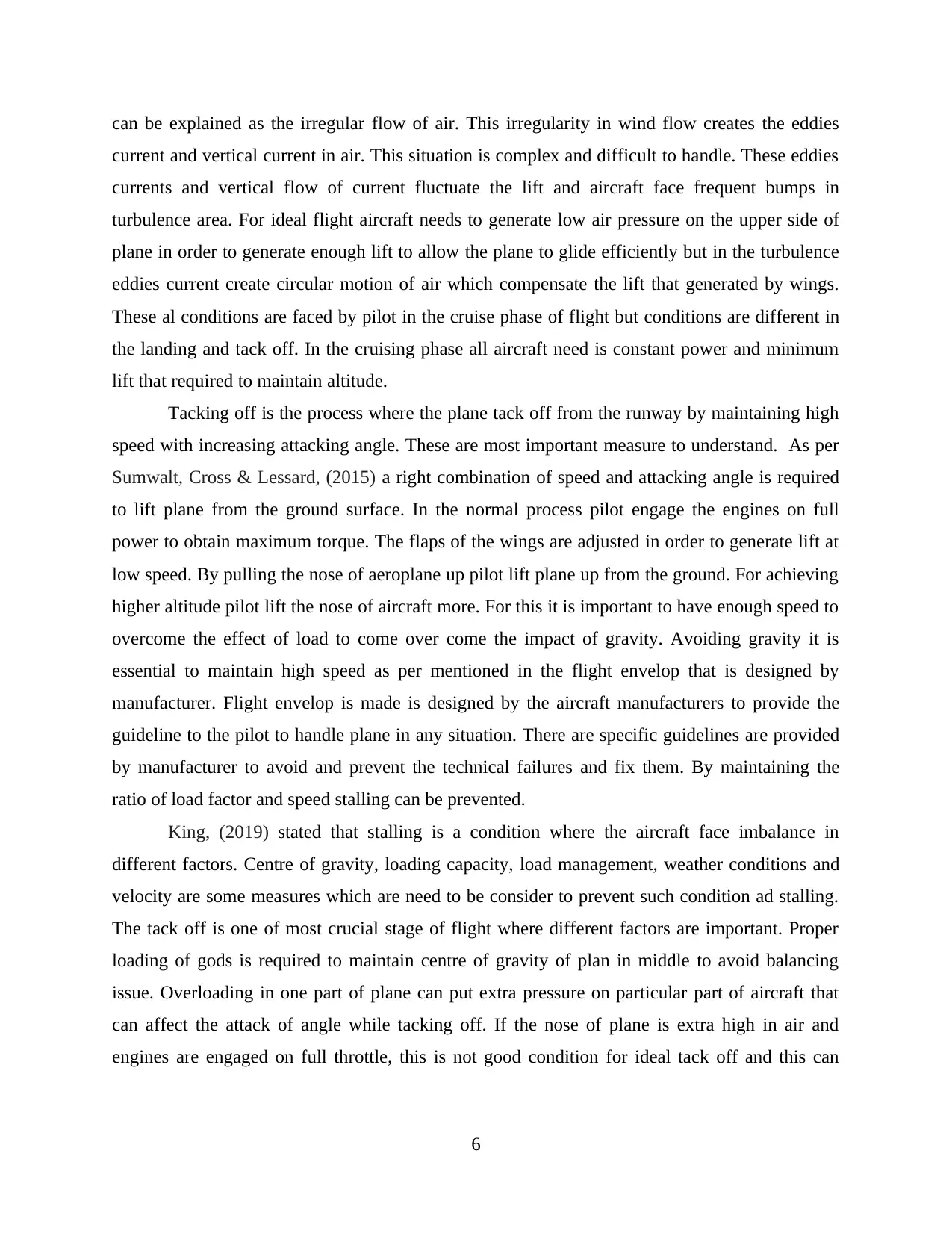
can be explained as the irregular flow of air. This irregularity in wind flow creates the eddies
current and vertical current in air. This situation is complex and difficult to handle. These eddies
currents and vertical flow of current fluctuate the lift and aircraft face frequent bumps in
turbulence area. For ideal flight aircraft needs to generate low air pressure on the upper side of
plane in order to generate enough lift to allow the plane to glide efficiently but in the turbulence
eddies current create circular motion of air which compensate the lift that generated by wings.
These al conditions are faced by pilot in the cruise phase of flight but conditions are different in
the landing and tack off. In the cruising phase all aircraft need is constant power and minimum
lift that required to maintain altitude.
Tacking off is the process where the plane tack off from the runway by maintaining high
speed with increasing attacking angle. These are most important measure to understand. As per
Sumwalt, Cross & Lessard, (2015) a right combination of speed and attacking angle is required
to lift plane from the ground surface. In the normal process pilot engage the engines on full
power to obtain maximum torque. The flaps of the wings are adjusted in order to generate lift at
low speed. By pulling the nose of aeroplane up pilot lift plane up from the ground. For achieving
higher altitude pilot lift the nose of aircraft more. For this it is important to have enough speed to
overcome the effect of load to come over come the impact of gravity. Avoiding gravity it is
essential to maintain high speed as per mentioned in the flight envelop that is designed by
manufacturer. Flight envelop is made is designed by the aircraft manufacturers to provide the
guideline to the pilot to handle plane in any situation. There are specific guidelines are provided
by manufacturer to avoid and prevent the technical failures and fix them. By maintaining the
ratio of load factor and speed stalling can be prevented.
King, (2019) stated that stalling is a condition where the aircraft face imbalance in
different factors. Centre of gravity, loading capacity, load management, weather conditions and
velocity are some measures which are need to be consider to prevent such condition ad stalling.
The tack off is one of most crucial stage of flight where different factors are important. Proper
loading of gods is required to maintain centre of gravity of plan in middle to avoid balancing
issue. Overloading in one part of plane can put extra pressure on particular part of aircraft that
can affect the attack of angle while tacking off. If the nose of plane is extra high in air and
engines are engaged on full throttle, this is not good condition for ideal tack off and this can
6
current and vertical current in air. This situation is complex and difficult to handle. These eddies
currents and vertical flow of current fluctuate the lift and aircraft face frequent bumps in
turbulence area. For ideal flight aircraft needs to generate low air pressure on the upper side of
plane in order to generate enough lift to allow the plane to glide efficiently but in the turbulence
eddies current create circular motion of air which compensate the lift that generated by wings.
These al conditions are faced by pilot in the cruise phase of flight but conditions are different in
the landing and tack off. In the cruising phase all aircraft need is constant power and minimum
lift that required to maintain altitude.
Tacking off is the process where the plane tack off from the runway by maintaining high
speed with increasing attacking angle. These are most important measure to understand. As per
Sumwalt, Cross & Lessard, (2015) a right combination of speed and attacking angle is required
to lift plane from the ground surface. In the normal process pilot engage the engines on full
power to obtain maximum torque. The flaps of the wings are adjusted in order to generate lift at
low speed. By pulling the nose of aeroplane up pilot lift plane up from the ground. For achieving
higher altitude pilot lift the nose of aircraft more. For this it is important to have enough speed to
overcome the effect of load to come over come the impact of gravity. Avoiding gravity it is
essential to maintain high speed as per mentioned in the flight envelop that is designed by
manufacturer. Flight envelop is made is designed by the aircraft manufacturers to provide the
guideline to the pilot to handle plane in any situation. There are specific guidelines are provided
by manufacturer to avoid and prevent the technical failures and fix them. By maintaining the
ratio of load factor and speed stalling can be prevented.
King, (2019) stated that stalling is a condition where the aircraft face imbalance in
different factors. Centre of gravity, loading capacity, load management, weather conditions and
velocity are some measures which are need to be consider to prevent such condition ad stalling.
The tack off is one of most crucial stage of flight where different factors are important. Proper
loading of gods is required to maintain centre of gravity of plan in middle to avoid balancing
issue. Overloading in one part of plane can put extra pressure on particular part of aircraft that
can affect the attack of angle while tacking off. If the nose of plane is extra high in air and
engines are engaged on full throttle, this is not good condition for ideal tack off and this can
6
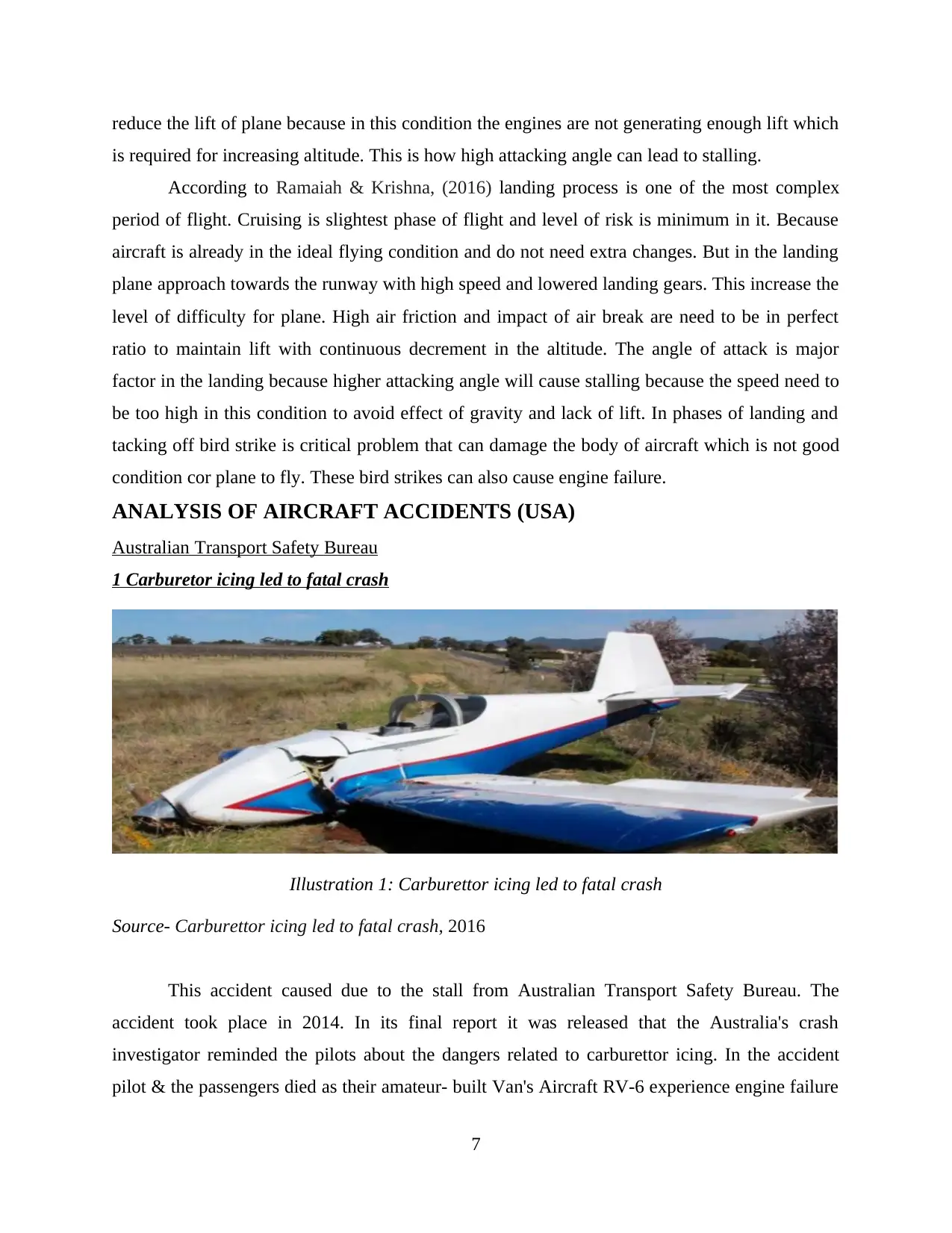
reduce the lift of plane because in this condition the engines are not generating enough lift which
is required for increasing altitude. This is how high attacking angle can lead to stalling.
According to Ramaiah & Krishna, (2016) landing process is one of the most complex
period of flight. Cruising is slightest phase of flight and level of risk is minimum in it. Because
aircraft is already in the ideal flying condition and do not need extra changes. But in the landing
plane approach towards the runway with high speed and lowered landing gears. This increase the
level of difficulty for plane. High air friction and impact of air break are need to be in perfect
ratio to maintain lift with continuous decrement in the altitude. The angle of attack is major
factor in the landing because higher attacking angle will cause stalling because the speed need to
be too high in this condition to avoid effect of gravity and lack of lift. In phases of landing and
tacking off bird strike is critical problem that can damage the body of aircraft which is not good
condition cor plane to fly. These bird strikes can also cause engine failure.
ANALYSIS OF AIRCRAFT ACCIDENTS (USA)
Australian Transport Safety Bureau
1 Carburetor icing led to fatal crash
Illustration 1: Carburettor icing led to fatal crash
Source- Carburettor icing led to fatal crash, 2016
This accident caused due to the stall from Australian Transport Safety Bureau. The
accident took place in 2014. In its final report it was released that the Australia's crash
investigator reminded the pilots about the dangers related to carburettor icing. In the accident
pilot & the passengers died as their amateur- built Van's Aircraft RV-6 experience engine failure
7
is required for increasing altitude. This is how high attacking angle can lead to stalling.
According to Ramaiah & Krishna, (2016) landing process is one of the most complex
period of flight. Cruising is slightest phase of flight and level of risk is minimum in it. Because
aircraft is already in the ideal flying condition and do not need extra changes. But in the landing
plane approach towards the runway with high speed and lowered landing gears. This increase the
level of difficulty for plane. High air friction and impact of air break are need to be in perfect
ratio to maintain lift with continuous decrement in the altitude. The angle of attack is major
factor in the landing because higher attacking angle will cause stalling because the speed need to
be too high in this condition to avoid effect of gravity and lack of lift. In phases of landing and
tacking off bird strike is critical problem that can damage the body of aircraft which is not good
condition cor plane to fly. These bird strikes can also cause engine failure.
ANALYSIS OF AIRCRAFT ACCIDENTS (USA)
Australian Transport Safety Bureau
1 Carburetor icing led to fatal crash
Illustration 1: Carburettor icing led to fatal crash
Source- Carburettor icing led to fatal crash, 2016
This accident caused due to the stall from Australian Transport Safety Bureau. The
accident took place in 2014. In its final report it was released that the Australia's crash
investigator reminded the pilots about the dangers related to carburettor icing. In the accident
pilot & the passengers died as their amateur- built Van's Aircraft RV-6 experience engine failure
7
⊘ This is a preview!⊘
Do you want full access?
Subscribe today to unlock all pages.

Trusted by 1+ million students worldwide
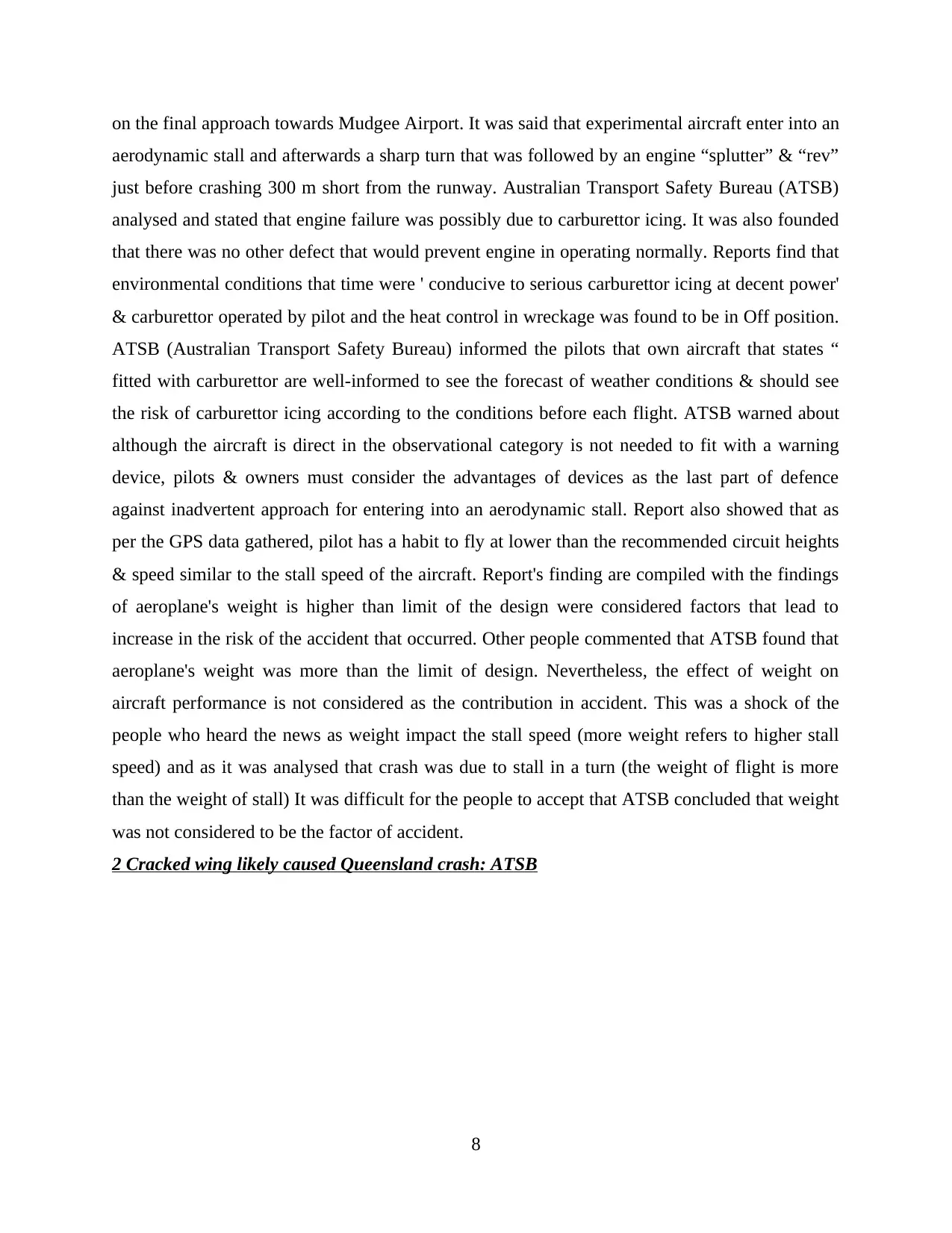
on the final approach towards Mudgee Airport. It was said that experimental aircraft enter into an
aerodynamic stall and afterwards a sharp turn that was followed by an engine “splutter” & “rev”
just before crashing 300 m short from the runway. Australian Transport Safety Bureau (ATSB)
analysed and stated that engine failure was possibly due to carburettor icing. It was also founded
that there was no other defect that would prevent engine in operating normally. Reports find that
environmental conditions that time were ' conducive to serious carburettor icing at decent power'
& carburettor operated by pilot and the heat control in wreckage was found to be in Off position.
ATSB (Australian Transport Safety Bureau) informed the pilots that own aircraft that states “
fitted with carburettor are well-informed to see the forecast of weather conditions & should see
the risk of carburettor icing according to the conditions before each flight. ATSB warned about
although the aircraft is direct in the observational category is not needed to fit with a warning
device, pilots & owners must consider the advantages of devices as the last part of defence
against inadvertent approach for entering into an aerodynamic stall. Report also showed that as
per the GPS data gathered, pilot has a habit to fly at lower than the recommended circuit heights
& speed similar to the stall speed of the aircraft. Report's finding are compiled with the findings
of aeroplane's weight is higher than limit of the design were considered factors that lead to
increase in the risk of the accident that occurred. Other people commented that ATSB found that
aeroplane's weight was more than the limit of design. Nevertheless, the effect of weight on
aircraft performance is not considered as the contribution in accident. This was a shock of the
people who heard the news as weight impact the stall speed (more weight refers to higher stall
speed) and as it was analysed that crash was due to stall in a turn (the weight of flight is more
than the weight of stall) It was difficult for the people to accept that ATSB concluded that weight
was not considered to be the factor of accident.
2 Cracked wing likely caused Queensland crash: ATSB
8
aerodynamic stall and afterwards a sharp turn that was followed by an engine “splutter” & “rev”
just before crashing 300 m short from the runway. Australian Transport Safety Bureau (ATSB)
analysed and stated that engine failure was possibly due to carburettor icing. It was also founded
that there was no other defect that would prevent engine in operating normally. Reports find that
environmental conditions that time were ' conducive to serious carburettor icing at decent power'
& carburettor operated by pilot and the heat control in wreckage was found to be in Off position.
ATSB (Australian Transport Safety Bureau) informed the pilots that own aircraft that states “
fitted with carburettor are well-informed to see the forecast of weather conditions & should see
the risk of carburettor icing according to the conditions before each flight. ATSB warned about
although the aircraft is direct in the observational category is not needed to fit with a warning
device, pilots & owners must consider the advantages of devices as the last part of defence
against inadvertent approach for entering into an aerodynamic stall. Report also showed that as
per the GPS data gathered, pilot has a habit to fly at lower than the recommended circuit heights
& speed similar to the stall speed of the aircraft. Report's finding are compiled with the findings
of aeroplane's weight is higher than limit of the design were considered factors that lead to
increase in the risk of the accident that occurred. Other people commented that ATSB found that
aeroplane's weight was more than the limit of design. Nevertheless, the effect of weight on
aircraft performance is not considered as the contribution in accident. This was a shock of the
people who heard the news as weight impact the stall speed (more weight refers to higher stall
speed) and as it was analysed that crash was due to stall in a turn (the weight of flight is more
than the weight of stall) It was difficult for the people to accept that ATSB concluded that weight
was not considered to be the factor of accident.
2 Cracked wing likely caused Queensland crash: ATSB
8
Paraphrase This Document
Need a fresh take? Get an instant paraphrase of this document with our AI Paraphraser
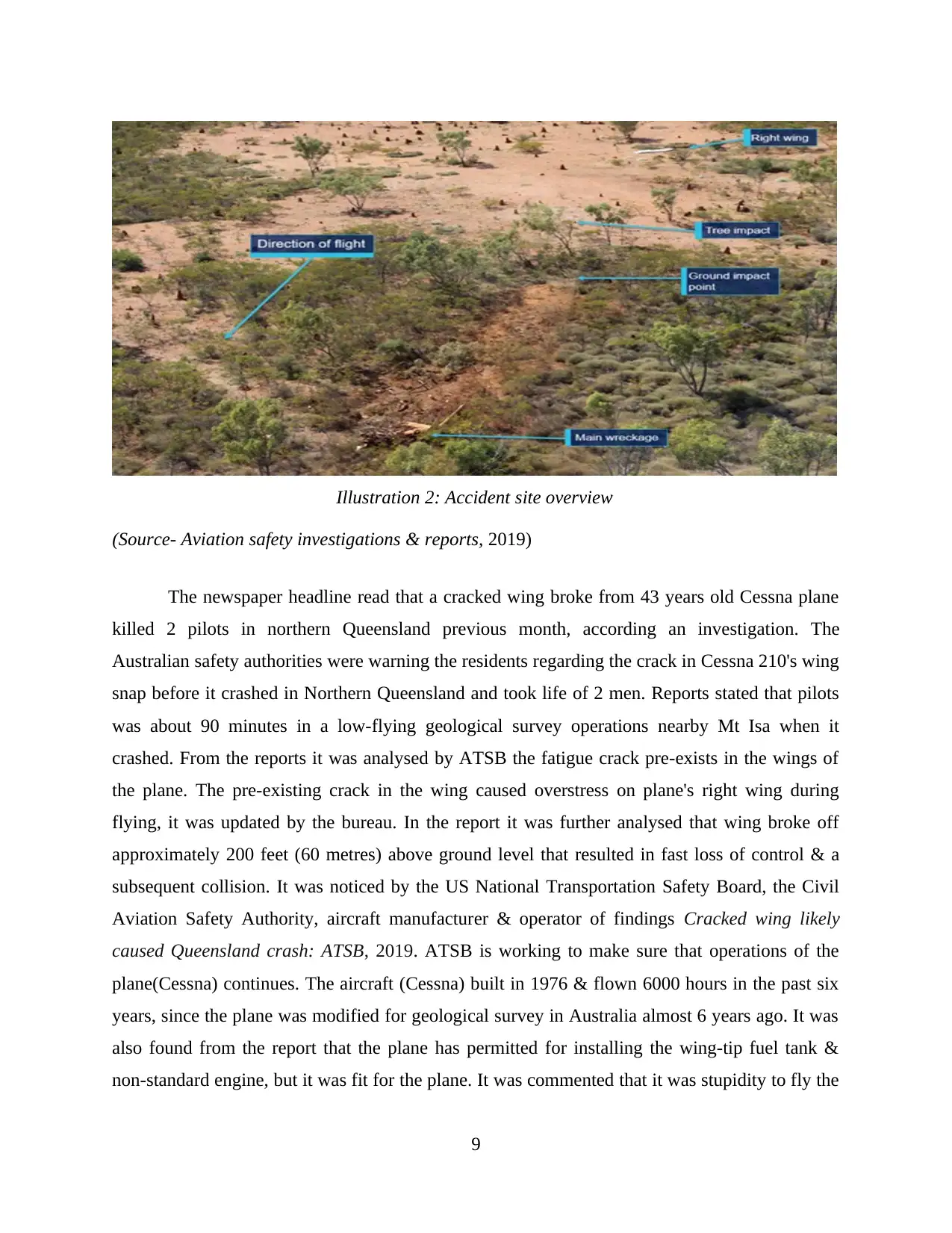
Illustration 2: Accident site overview
(Source- Aviation safety investigations & reports, 2019)
The newspaper headline read that a cracked wing broke from 43 years old Cessna plane
killed 2 pilots in northern Queensland previous month, according an investigation. The
Australian safety authorities were warning the residents regarding the crack in Cessna 210's wing
snap before it crashed in Northern Queensland and took life of 2 men. Reports stated that pilots
was about 90 minutes in a low-flying geological survey operations nearby Mt Isa when it
crashed. From the reports it was analysed by ATSB the fatigue crack pre-exists in the wings of
the plane. The pre-existing crack in the wing caused overstress on plane's right wing during
flying, it was updated by the bureau. In the report it was further analysed that wing broke off
approximately 200 feet (60 metres) above ground level that resulted in fast loss of control & a
subsequent collision. It was noticed by the US National Transportation Safety Board, the Civil
Aviation Safety Authority, aircraft manufacturer & operator of findings Cracked wing likely
caused Queensland crash: ATSB, 2019. ATSB is working to make sure that operations of the
plane(Cessna) continues. The aircraft (Cessna) built in 1976 & flown 6000 hours in the past six
years, since the plane was modified for geological survey in Australia almost 6 years ago. It was
also found from the report that the plane has permitted for installing the wing-tip fuel tank &
non-standard engine, but it was fit for the plane. It was commented that it was stupidity to fly the
9
(Source- Aviation safety investigations & reports, 2019)
The newspaper headline read that a cracked wing broke from 43 years old Cessna plane
killed 2 pilots in northern Queensland previous month, according an investigation. The
Australian safety authorities were warning the residents regarding the crack in Cessna 210's wing
snap before it crashed in Northern Queensland and took life of 2 men. Reports stated that pilots
was about 90 minutes in a low-flying geological survey operations nearby Mt Isa when it
crashed. From the reports it was analysed by ATSB the fatigue crack pre-exists in the wings of
the plane. The pre-existing crack in the wing caused overstress on plane's right wing during
flying, it was updated by the bureau. In the report it was further analysed that wing broke off
approximately 200 feet (60 metres) above ground level that resulted in fast loss of control & a
subsequent collision. It was noticed by the US National Transportation Safety Board, the Civil
Aviation Safety Authority, aircraft manufacturer & operator of findings Cracked wing likely
caused Queensland crash: ATSB, 2019. ATSB is working to make sure that operations of the
plane(Cessna) continues. The aircraft (Cessna) built in 1976 & flown 6000 hours in the past six
years, since the plane was modified for geological survey in Australia almost 6 years ago. It was
also found from the report that the plane has permitted for installing the wing-tip fuel tank &
non-standard engine, but it was fit for the plane. It was commented that it was stupidity to fly the
9
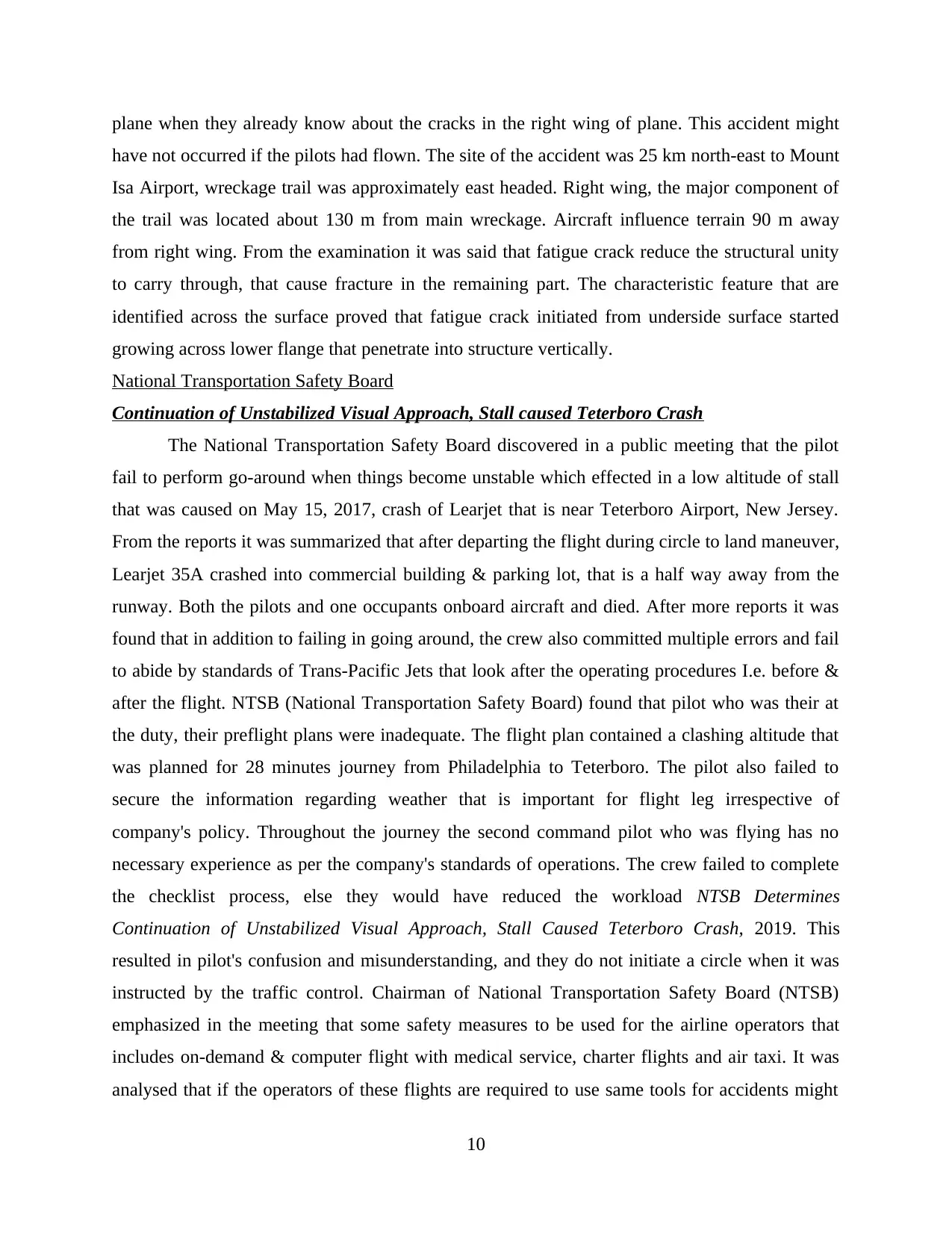
plane when they already know about the cracks in the right wing of plane. This accident might
have not occurred if the pilots had flown. The site of the accident was 25 km north-east to Mount
Isa Airport, wreckage trail was approximately east headed. Right wing, the major component of
the trail was located about 130 m from main wreckage. Aircraft influence terrain 90 m away
from right wing. From the examination it was said that fatigue crack reduce the structural unity
to carry through, that cause fracture in the remaining part. The characteristic feature that are
identified across the surface proved that fatigue crack initiated from underside surface started
growing across lower flange that penetrate into structure vertically.
National Transportation Safety Board
Continuation of Unstabilized Visual Approach, Stall caused Teterboro Crash
The National Transportation Safety Board discovered in a public meeting that the pilot
fail to perform go-around when things become unstable which effected in a low altitude of stall
that was caused on May 15, 2017, crash of Learjet that is near Teterboro Airport, New Jersey.
From the reports it was summarized that after departing the flight during circle to land maneuver,
Learjet 35A crashed into commercial building & parking lot, that is a half way away from the
runway. Both the pilots and one occupants onboard aircraft and died. After more reports it was
found that in addition to failing in going around, the crew also committed multiple errors and fail
to abide by standards of Trans-Pacific Jets that look after the operating procedures I.e. before &
after the flight. NTSB (National Transportation Safety Board) found that pilot who was their at
the duty, their preflight plans were inadequate. The flight plan contained a clashing altitude that
was planned for 28 minutes journey from Philadelphia to Teterboro. The pilot also failed to
secure the information regarding weather that is important for flight leg irrespective of
company's policy. Throughout the journey the second command pilot who was flying has no
necessary experience as per the company's standards of operations. The crew failed to complete
the checklist process, else they would have reduced the workload NTSB Determines
Continuation of Unstabilized Visual Approach, Stall Caused Teterboro Crash, 2019. This
resulted in pilot's confusion and misunderstanding, and they do not initiate a circle when it was
instructed by the traffic control. Chairman of National Transportation Safety Board (NTSB)
emphasized in the meeting that some safety measures to be used for the airline operators that
includes on-demand & computer flight with medical service, charter flights and air taxi. It was
analysed that if the operators of these flights are required to use same tools for accidents might
10
have not occurred if the pilots had flown. The site of the accident was 25 km north-east to Mount
Isa Airport, wreckage trail was approximately east headed. Right wing, the major component of
the trail was located about 130 m from main wreckage. Aircraft influence terrain 90 m away
from right wing. From the examination it was said that fatigue crack reduce the structural unity
to carry through, that cause fracture in the remaining part. The characteristic feature that are
identified across the surface proved that fatigue crack initiated from underside surface started
growing across lower flange that penetrate into structure vertically.
National Transportation Safety Board
Continuation of Unstabilized Visual Approach, Stall caused Teterboro Crash
The National Transportation Safety Board discovered in a public meeting that the pilot
fail to perform go-around when things become unstable which effected in a low altitude of stall
that was caused on May 15, 2017, crash of Learjet that is near Teterboro Airport, New Jersey.
From the reports it was summarized that after departing the flight during circle to land maneuver,
Learjet 35A crashed into commercial building & parking lot, that is a half way away from the
runway. Both the pilots and one occupants onboard aircraft and died. After more reports it was
found that in addition to failing in going around, the crew also committed multiple errors and fail
to abide by standards of Trans-Pacific Jets that look after the operating procedures I.e. before &
after the flight. NTSB (National Transportation Safety Board) found that pilot who was their at
the duty, their preflight plans were inadequate. The flight plan contained a clashing altitude that
was planned for 28 minutes journey from Philadelphia to Teterboro. The pilot also failed to
secure the information regarding weather that is important for flight leg irrespective of
company's policy. Throughout the journey the second command pilot who was flying has no
necessary experience as per the company's standards of operations. The crew failed to complete
the checklist process, else they would have reduced the workload NTSB Determines
Continuation of Unstabilized Visual Approach, Stall Caused Teterboro Crash, 2019. This
resulted in pilot's confusion and misunderstanding, and they do not initiate a circle when it was
instructed by the traffic control. Chairman of National Transportation Safety Board (NTSB)
emphasized in the meeting that some safety measures to be used for the airline operators that
includes on-demand & computer flight with medical service, charter flights and air taxi. It was
analysed that if the operators of these flights are required to use same tools for accidents might
10
⊘ This is a preview!⊘
Do you want full access?
Subscribe today to unlock all pages.

Trusted by 1+ million students worldwide
1 out of 24
Your All-in-One AI-Powered Toolkit for Academic Success.
+13062052269
info@desklib.com
Available 24*7 on WhatsApp / Email
![[object Object]](/_next/static/media/star-bottom.7253800d.svg)
Unlock your academic potential
Copyright © 2020–2025 A2Z Services. All Rights Reserved. Developed and managed by ZUCOL.